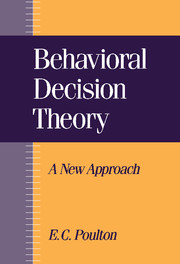Book contents
- Frontmatter
- Acknowledgments
- Contents
- Preface
- Chapter 1 Outline of heuristics and biases
- Chapter 2 Practical techniques
- Chapter 3 Apparent overconfidence
- Chapter 4 Hindsight bias
- Chapter 5 Small sample fallacy
- Chapter 6 Conjunction fallacy
- Chapter 7 Regression fallacy
- Chapter 8 Base rate neglect
- Chapter 9 Availability and simulation fallacies
- Chapter 10 Anchoring and adjustment biases
- Chapter 11 Expected utility fallacy
- Chapter 12 Bias by frames
- Chapter 13 Simple biases accompanying complex biases
- Chapter 14 Problem questions
- Chapter 15 Training
- Chapter 16 Overview
- References
- Index
Chapter 13 - Simple biases accompanying complex biases
Published online by Cambridge University Press: 06 July 2010
- Frontmatter
- Acknowledgments
- Contents
- Preface
- Chapter 1 Outline of heuristics and biases
- Chapter 2 Practical techniques
- Chapter 3 Apparent overconfidence
- Chapter 4 Hindsight bias
- Chapter 5 Small sample fallacy
- Chapter 6 Conjunction fallacy
- Chapter 7 Regression fallacy
- Chapter 8 Base rate neglect
- Chapter 9 Availability and simulation fallacies
- Chapter 10 Anchoring and adjustment biases
- Chapter 11 Expected utility fallacy
- Chapter 12 Bias by frames
- Chapter 13 Simple biases accompanying complex biases
- Chapter 14 Problem questions
- Chapter 15 Training
- Chapter 16 Overview
- References
- Index
Summary
Summary
In 28 of the investigations described in this book, a simple bias of quantification accompanies a complex bias in dealing with probabilities. In 11 of these investigations the simple bias can account for the full effect attributed to the complex bias. In another 5 investigations the simple bias can have a greater or as great an effect as the complex bias. In 3 more investigations the simple bias can either increase or reduce the effect of a complex bias. In the other 9 investigations the simple bias can account for an incidental effect that is found while investigating a complex bias.
Investigations with both simple and complex biases
Table 13.1 lists 28 investigations that involve both a simple bias in quantifying judgments and a complex bias in estimating probabilities. Column 3 of the table shows that the simple response contraction bias accounts for 18, or 64%, of the investigations. Transfer bias and the equal frequency bias account for another 22% and 11% respectively. The 3 most commonly associated complex biases are apparent overconfidence or underconfidence, 36%, the availability and simulation fallacies, 25%, and the expected utility fallacy, 11%. However, the exact proportions of both the simple and complex biases depend on the particular investigations described in this book.
In discussing investigations with both simple and complex biases, investigators characteristically concentrate on the complex bias that they are studying. They pay little or no attention to the accompanying simple bias.
- Type
- Chapter
- Information
- Behavioral Decision TheoryA New Approach, pp. 241 - 253Publisher: Cambridge University PressPrint publication year: 1994



